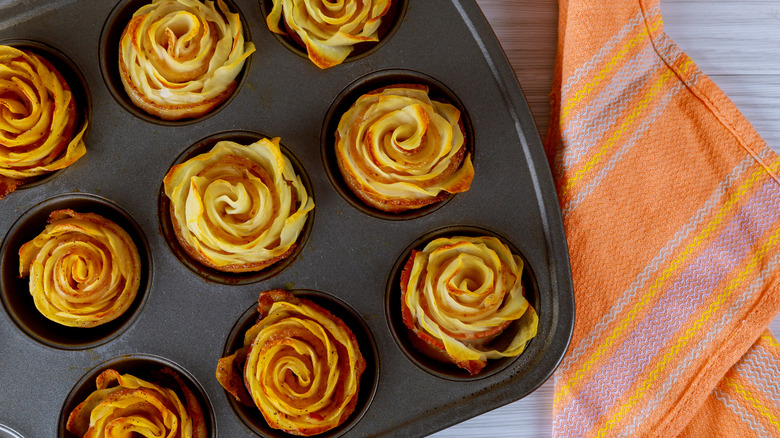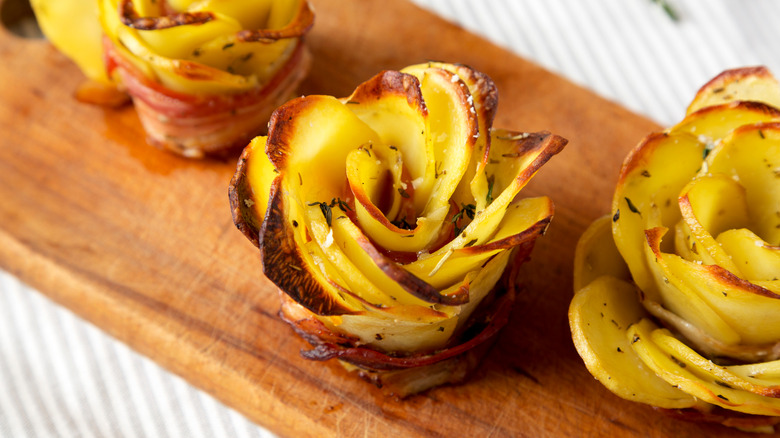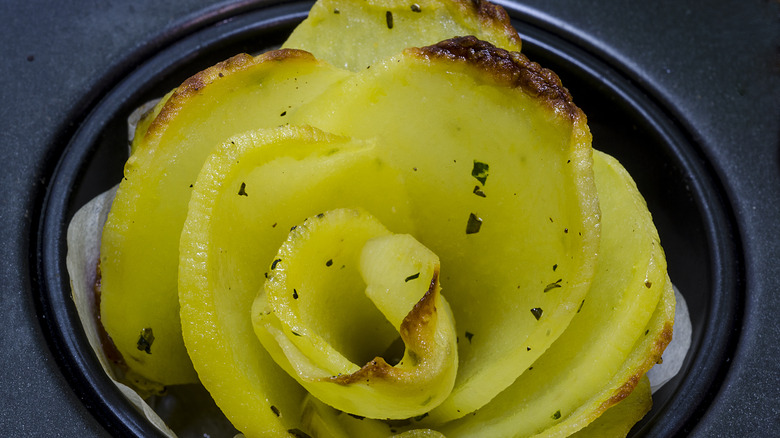Potato Gratin Roses Are Sure To Be The Star Of Your Next Dinner Party
There's a spectrum of culinary expression that begins with cooking and ends with presentation. Along it lies everything from a humble bowl of oatmeal — even when dressed up with tasty toppings – to the fiery flash of bananas foster. (Upscale restaurants, of course, take it even further, sometimes prioritizing aesthetics over appetizing food.) "Animals feed themselves; men eat," French gourmand Jean Anthelme Brillat-Savarin once declared, "But only wise men know that art of eating." It's one thing to make a luscious, creamy potato gratin at home in a baking dish, but it's quite another to present little, lightly-browned gratin roses to your dinner guests — or just someone special.
Potato gratin roses differ slightly from the French classic potatoes au gratin in that they ditch the traditional heavy cream and Gruyère cheese because the added weight, while making the dish voluptuous, puts the thinly sliced potatoes flat on their back. The rosette shape of this dish requires its potato petals to remain upright. But don't worry — there's still cheese in this gratin: It comes in the form of grated parmesan. The result has delectably crisp brown edges and a tantalizing, romantic shape.
A rose by any other name would still be delicious
Interestingly, it's the crust that makes this dish a legitimate gratin because, along with the addition of cheese, a traditional gratin has a crisp crust provided by butter, high heat, and sometimes breadcrumbs. Potato gratin roses take this to a breathtaking new level, with the edges of each potato petal baking to a perfect brown crisp. It's an altogether lighter, more aesthetically pleasing version of the classic.
To achieve this rose-shaped crispness, you will need a couple of things: The ability to slice each potato very thinly (yet another reason to buy a mandoline, one of the handiest kitchen tools in existence) as well as a flavorful fat in the form of either olive oil or butter. The final requirement is architectural: It's necessary for the rose shapes to hold together and remain vertical. This trick is easily accomplished with yet another kitchen staple, the muffin tin.
Making magic in a muffin tin
So, you've sliced your potatoes exquisitely thinly on a mandoline, covered them generously with herbs and spices, grated some snappy Parmigiano-Reggiano over the top, and smothered them in olive oil or butter. Now, you can either place the potatoes in uneven, overlapping slices in the muffin tin, or on top of slices of bacon first for extra flavor. (We do recommend using a nonstick muffin tin. Potatoes are starchy little devils, and they'll naturally want to weld themselves onto any surface that isn't nonstick or greased within an inch of its life. Save yourself the heartbreak of protracted extraction.) Then into a hot oven they go.
Now imagine these gorgeous rosettes sitting alongside a perfectly-seared steak and a healthy serving of slightly bitter, wilted rapini greens, pan sautéed with olive oil and red chili flakes. Light a couple of taper candles and immerse yourself in the art of eating.


